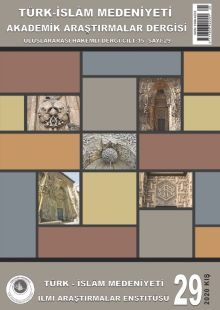Herbal Compositions with Biaxial Infinite Character in Anatolian Seljuk Art
Keywords:
Anatolian Seljuk, border, herbal ornament, geometric decorationAbstract
Decorations in Anatolian Seljuk art have been analyzed under the headings of geometric, herbal, figurative and writing. Geometric ornaments that were used extensively from the late 12th century to the first half of the 13th century reveal itself with a certain level of development even in the early Seljuk structures. Towards the end of the 13th century, the structures were mostly decorated with herbal compositions. The herbal ornaments that were previously seen on small borders were gradually used on the whole surface of the portal. Limited compositions and uniaxial infinite character compositions constitute the vast majority of herbal compositions that can reach hundreds of different forms. Very few of the biaxial endless characters of herbal compositions, which have become widespread even in the main borders over time, are found in the Anatolian Seljuk art. This can be interpreted as the development of herbal decoration in Anatolian Seljuk art could not be completed as much as geometric decoration and it can also be said that this is due to the short duration of the intensive use of herbal compositions. The aim of this study was to determine the biaxial herbal compositions with infinite character whose numbers are quite few, in Anatolian Seljuk structures and investigate the properties of them.
References
Bozer, R. (1992). 15. Yüzyılın Ortasına Kadar Anadolu Türk Sanatında Ahşap Kapılar, (Yayınlanmamış Doktora Tezi), Ankara Üniversitesi Sosyal Bilimler Enstitüsü, Ankara.
Bulut, M. (2017). “Geometrik Sistemin Çözümlenmesi Selçuklu Örnekleri Üzerine Birkaç Girişim”, Sanat Tarihi Dergisi, S. XXVI/1, İzmir, s. 27-44.
Bulut, M. (2019). “Anadolu Selçuklu Sanatında Kompozisyon-Derz İlişkisi”, Atatürk Üniversitesi Güzel Sanatlar Enstitüsü Dergisi, S: 42, Erzurum, , s. 254-265.
Doğanay, A. (2009). Osmanlı Tezyinatı, Klasik Devir Osmanlı Hanedan Türbeleri 1522-1604, Klasik Yayınları, İstanbul.
Dursun, Ş. (2016). Anadolu Selçuklu Kervansaraylarında Süsleme, (Yayınlanmamış Doktora Tezi), Selçuk Üniversitesi Sosyal Bilimler Enstitüsü, Konya,
Erdmann, K..-Erdmann, H. (1976). Das Anatolische Karavansaray des 13.Jahrhunderts, III, Berlin: Verlag Gebrüder Mann.
Kuban, D. (1999). Divriği Mucizesi, Selçuklular Çağında İslam Bezeme Sanatı Üzerine Bir Deneme, Yapı Kredi Kültür Sanat Yayıncılık, İstanbul.
Mülayim, S. (1982). Anadolu Selçuklu Mimarisinde Geometrik Süslemeler, Selçuklu Çağı, Kültür ve Turizm Bakanlığı Yayınları, Ankara.
Ögel, S., (1966). Anadolu Selçukluları’nın Taş Tezyinatı, Türk Tarih Kurumu, Ankara.
Ögel, S. (2006). Taçkapılar, Anadolu Selçukluları ve Beylikler Dönemi Uygarlığı 2, Kültür ve Turizm Bakanlığı, Ankara, s. 469-486.
Öney, G. (1992). Anadolu Selçuklu Mimari Süsleme ve El Sanatları, İş Bankası Kültür Yayınları, Ankara.
Özbek, Y. (2002). Osmanlı Beyliği Mimarisinde Taş Süsleme (1300-1453), Kültür Bakanlığı Yayınları, Ankara.
Şimşir, Z. (1990). Konya Selçuklu Medreseleri Çinilerde Kullanılan Motifler, (Yayımlanmamış Yüksek Lisans Tezi), Selçuk Üniversitesi Sosyal Bilimler Enstitüsü, Konya.
Ünal, R.H. (1982). Osmanlı Öncesi Anadolu-Türk Mimarisinde Taçkapılar, Ege Üniversitesi Edebiyat Fakültesi Yayınları, İzmir.
Yetkin, Ş. (1972). Anadolu’da Türk Çini Sanatının Gelişimi, İ.Ü. Edebiyat Fakültesi Yayınları, İstanbul.
Downloads
Published
How to Cite
Issue
Section
License

This work is licensed under a Creative Commons Attribution-NonCommercial 4.0 International License.







